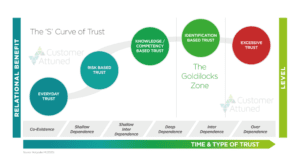B2B Trust as a Predictive Indicator
With the role of Trust in leadership and, therefore, within organisations under constant scrutiny, Customer Experience expert Peter Lavers asks the question: Is measuring Trust in B2B relationships and partnerships a predictive indicator of mutual value and customer loyalty?
I suspect that many readers will intuitively agree that increasing or declining trust within a B2B relationship will inevitably lead to better or worse outcomes, and that maintaining an adequate level of trust between a supplier and their customer or partner will lead to longevity of relationship.
Please keep reading if you don’t agree, because that’s exactly what this blog is setting out to examine.
If it’s true, then why isn’t trust measurement and management much higher up the corporate agenda? If it’s not true, then why do corporate executives always talk about “rebuilding trust” when they’ve messed up?!
What is B2B Trust?
In considering this vital dynamic of B2B relationships, I have referred back to my colleague Dr Mark Hollyoake’s ground breaking work on B2B Trust. In it he has academically tested and proven a fascinating definition.
B2B Trust is:
“The willingness to be vulnerable to another party and the decision to engage in actions
based upon an interpretation of their ability, credibility and the expectations of
mutual value exchange over time”
(Source Hollyoake M, 2020)
You will note that its closing phrase talks about “expectations”. At the very start of a new business relationship, intentions and expectations are all you have (I cover this in my blog about contract activation), but the reality of working together soon sets in, which either confirms or erodes that trust.
Further down the line, the effect of the relationship can be evaluated, and Dr Mark argues compellingly that mutual value (see below) should be the foremost aim of a trust-based business relationship.
This is thought provoking, but at this level it’s not predictive of a successful relationship. To achieve this, we need to dig deeper.
Predictive Indicator of What?
Predictive indicators need to be:
- Based on verified, quality historic data that has been tested for predictability by Data Science teams
- Able to have statistical algorithms applied, including machine learning or AI, to forecast future outcomes
- Anticipating of trends and enabling of data-driven decisions.
 Fortunately, Dr Mark’s work came up with much more than a headline definition. His Trust DNATM model (illustrated) breaks down into eight distinct elements of trust, underneath which sits a catalogue of incidents, behaviours and attitudes that either build or damage trust within and across the working relationship.
Fortunately, Dr Mark’s work came up with much more than a headline definition. His Trust DNATM model (illustrated) breaks down into eight distinct elements of trust, underneath which sits a catalogue of incidents, behaviours and attitudes that either build or damage trust within and across the working relationship.
The model covers the intention/reality/effect continuum as mentioned above, and two of the elements are clear outcomes that result from this virtuous circle of trust:
- Mutual Value: Returning fair and equitable commercial value to both sides
- Time/Repeatability: Continued delivery of mutual value makes both sides want to do it again (i.e. loyalty is built on both sides) – perhaps even evolving into a strategic partnership.
Levels of Trust as a Predictive Indicator of Value
 Another ground breaking finding from Dr Mark’s work was that trust operates in an “S curve” (also shown), which he explains in a short series of webcasts that are well worth watching.
Another ground breaking finding from Dr Mark’s work was that trust operates in an “S curve” (also shown), which he explains in a short series of webcasts that are well worth watching.
To the left of the curve is Everyday Trust, which tends to be transactional and low risk. Consequently, value and loyalty are relatively predictable based on transaction quality.
The next level is Risk Based Trust, where more dependency is involved and Agreements and contracts are framed around concrete commitments or SLAs. Outcome predictability at this level is directly related to contractual performance – in addition to transaction quality, as each stage of the S curve is cumulative to the previous stage.
If you weren’t in full agreement about my opening statement, then I suspect that most of your B2B relationships operate at these first two levels, where primarily behavioural and performance models can be built to forecast / predict likely outcomes and propensity. I would argue that trust is no less important, it just correlates better to these factors of basic service delivery.
Some business relationships further develop into Knowledge Based Trust, where openness and collaboration exist beyond simple customer/supplier contracts. Strategic insights are shared, which form the foundation for longer-term joint initiatives and working. At this level the “softer” elements of business relationship become important for predictability e.g. cultural fit and collaboration.
At the top of the curve there is Identification Based Trust, where the two partners are fully committed to mutual value co-creation, knowing each other so well that they anticipate and solve business issues before damage is done! Predictability here becomes about whether this level of interdependence can be maintained. The alternative is slipping back down the curve, or tipping over into excessive trust.
It’s worth noting that the S curve itself adds another valuable feature to predict – whether the relationship will grow up the curve, remain stable, or slide down back to heavily contract-based or transactional dealings. Both the opportunity and appetite to move up the curve are incorporated into our approach to B2B customer segmentation.
I hope that you agree that a mechanism that could predict both the value / loyalty outcomes and direction of travel on the S curve would be highly valuable.
Assessing Trust as a Predictive Indicator
This takes us back to my opening question – why isn’t trust measurement and management much higher up the corporate agenda?
Predictability needs historic data, but this very often isn’t there – particularly the higher up the S curve you get. This means that the risk of relationships not being maintained or grown are not quantified or visible to decision makers. We believe that investment can fill this important gap in insight.
The Partnership Survey from Customer Attuned Ltd, for example, utilises Dr Mark Hollyoake’s Trust DNA™ model and catalogue to give a wealth of insight into what’s working or not, and predict whether the relationship is improving or deteriorating. For example, we were able to uncover some concerning “decoupling behaviours” appearing in one of our client’s key relationships. Alerting senior stakeholders early enough enabled them to take action to avoid the relationship going sour.
Versions of our approach have also been applied to wider Voice of Customer and Staff programmes. These activities provide data that can be incorporated into predictive and segmentation models.
To find out more about our approach, please read our Partnership Survey page, or contact us.
- Customer Strategy in the B2B Membership Sector - May 27, 2025
- Build a B2B Customer Strategy - May 20, 2025
- Should you implement NPS in B2B? - January 22, 2025





